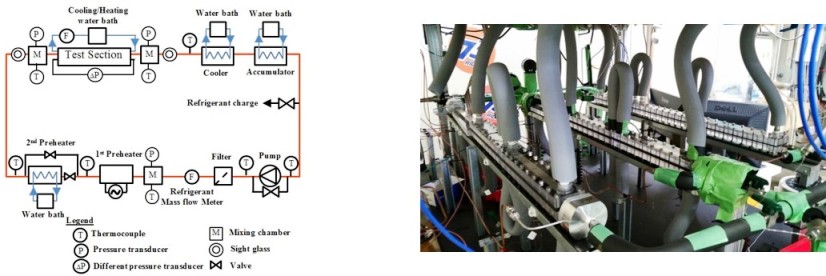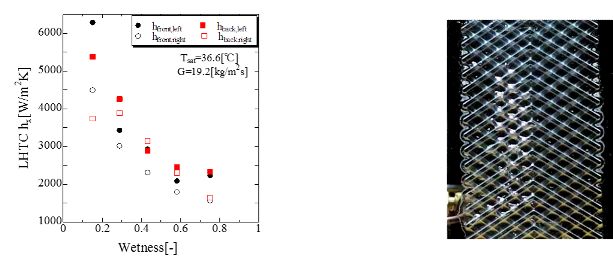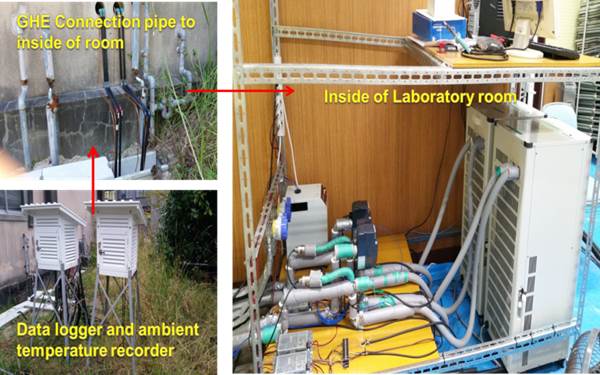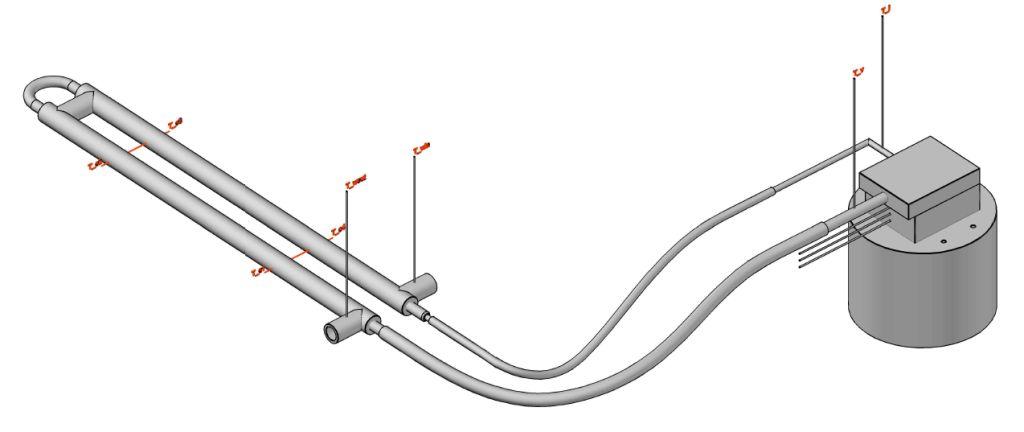
 |
| HOME |
MEMBER | RESEARCH | JOBS after GRADUATION (JP) |
ACCESS | JAPANESE | INTERNAL ONLY |
Introduction of studies |
Heat transfer characteristics of boiling and condensation heat transfer in a multi-port tube |
|
World will lose up to 39% of its land by 2100 because rising sea level, if continue global warming (APA, University of Wisconsin-Madison, 2007). This is one of many threats from man made global warming problem facing today’s world. Air conditioning, refrigeration and heat pump sectors are prior responsible for the man made Global Warming Problem (GWP) directly and indirectly. The direct impacts are due to the emissions of high GWP refrigerants emissions to the environment and the indirect impacts are for the greenhouse gas emissions associated with the energy uses by those systems. These two problems can possibly be minimized by refrigerants that are of zero ODP (ozone depleting potential) and low GWP and by making energy efficient systems. Most of the good candidates of the next generation refrigerants main problem is the heat transfer degradation. Therefore, heat transfer enhancement is a mandatory and urgent issu to overcome the heat transfer degradation. Presently, among the many heat transfer enhancement techniques multiport mini-channel heat exchangers are a particular target of advanced research as a heat transfer enhancement technique for the heat exchange in the field of air conditioning, refrigeration and heat pump sector due to their higher heat transfer with good surface temperature uniformity, air-side pressure drop, reduced weight and substantial refrigerant charge reduction as well as their space, energy, and material savings potential. In order to investigate the boiling and condensation heat transfer and pressure drop of refrigerant in a minichannel, a new experimental apparatus as shown in Fig. 1 & Fig. 2, has been fabricated. The boiling and condensation heat transfer and pressure drop will be measured over a range of test conditions. Two phase heat transfer and pressure drop prediction correlations will be developed considering flow regimes through the generating experimental databank. |

|
| Fig. 1 Schematic diagram of experimental apparatus Fig. 2 Photograph of the test section |
Heat transfer characteristics of boiling and condensation heat transfer in a plate heat exchanger |
|
Plate heat exchangers (PHEs) have been commonly used in industrial applications and air-conditioning systems for several decades such as food processing, heating or cooling in industrial processes and refrigeration or air conditioning plants. Plate heat exchangers (PHEs) are gaining popularity in recent years, due to their effectiveness, flexibility, compactness and competitive cost when compared with other types of heat exchangers. However, owing to flow complexity inside a plate heat exchanger, very few results have been published in the literature for evaporation and condensation heat transfer of refrigeration in plate heat exchangers. It is well known that two phase heat transfer in heat exchanger is a more efficient mode of heat transfer compared to single phase heat transfer. Although some two phase work on compact heat exchangers was reported in the last century, however, major two phase experimentation on plate heat exchangers has been reported in the last decade. In current research, the local heat transfer coefficient and flow visualization of two phase flow are experimentally evaluating in chevron type plate heat exchanger. To clarify heat transfer characteristics and flow behavior of two phase flow inside a chevron type plate heat exchanger, several experiments of boiling and condensation are conducting in various conditions. Some experimental results are shown in figure 1 and figure 2. It aims to the further understanding of flow phenomena and heat transfer characteristics inside the chevron type plate heat exchanger. |

|
| Fig.1 Local heat transfer coefficient of PHE Fig. 2 Photograph of the test section |
Study on transport properties of alternative low GWP refrigerant |
|
The growing international concern on global warming has motivated interest in a new generation of low-GWP refrigerants. Transport properties of these potential alternative refrigerants are very important to design and performance evaluation of the refrigeration system. So, the key objective of this research is to measure and predict the two most important transport property thermal conductivity and viscosity. For thermal conductivity measurement of low-GWP refrigerant, a well-known transient hot wire method is used. In this method, transient temperature rise of a thin wire is measured and thermal conductivity is obtained from the slope of the temperature rise with time. It is considered as a most reliable and accurate method of thermal conductivity measurement. We have constructed three experimental setups for precise measurement of thermal conductivity from low to high temperatures and from low to moderate pressure. Viscosity is measured with tandem capillary tube method. In this method two glass capillary tubes are used and pressure drop between the tubes are measured to get viscosity. We have constructed three experimental setups for precise measurement of viscosity from low to high temperatures and from low to moderate pressure. Prediction of thermal conductivity and viscosity is another key objective of this research. Extended Corresponding States (ECS) method is used along with experimental measurement to get prediction correlations for low-GWP refrigerants. |

|
| Fig.1 Measuring apparatus of thermal conductivity Fig.2 Measuring apparatus for viscosity |
Study on Ground Source Heat Pump (GSHP) system |
| Ground-source heat pump (GSHP) system is a kind of technology that uses geothermal energy as a heat source (in the winter) or a heat sink (in the summer) for space heating, cooling as well as for providing domestic hot water that transfers heat to or from the ground. GSHP systems provide higher efficiency and more environmental-friendly compared to conventional air source heat pump systems.
In order to gain an understanding of how well GSHPs function after installation, an analysis of their performance needs to be conducted. The performance of GSHP is strongly depends on the GHE performance. So for improving the overall efficiency of GSHPs, it is needed to improve the heat transfer efficiency in the soil, adopting more advanced shapes and devices. The high installation cost of vertical GHE can be reduced significantly by installing GHE in horizontal configuration. Since the shallow HGHEs give lower energy output than vertical GHEs, it is best opportunity to improve the efficiency of HGHEs by selecting of different geometries from single pipe, multiple pipes, and coiled pipe that looks like a slinky toy. Our GSHP group presently working with experimental investigation of thermal performance for slinky horizontal ground heat exchangers in several operation conditions. The slinky type horizontal ground heat exchangers (HGHEs) in two orientations have been considered such as reclined (parallel to ground surface) and standing (perpendicular to ground surface) using outer surface low density polyethylene (LDPE) coated copper tube. The ground temperature distribution up-to 10m depth, atmospheric air temperature and ground surface heat flux are also conducting. Also it is possible to measure the pressure losses in GHE tube by using differential pressure sensors. |

|
|
|

|
| Fig.2 Installation of slinky-coil ground heat exchangers Fig.3 Outer surface LDPE coated copper tube |
Flow characteristics of refrigerant during defrost process |
| Under construction.. |
Heat transfer characteristics of Loop Heat Pipe (LHP) |
| The loop heat pipe was firstly invented and tested in 1971 by Gerasimov and Maidanik at the Urals Technical University in Russia. Principle operation of the LHP is similar to conventional heat pipe (HP), except the separation between the liquid line and the vapor line as well as the appearance of capillary structure only inside the evaporator. Because of the above characteristics, LHP can transfer the larger heat power with the smaller thermal resistance through the longer distance to compare with normal HP. As a result, nowadays, LHP is considered as one of the most suitable solutions for managing operating temperature of electronics such as processors operating in the data centers or high performance computers which consume a huge amount of electric energy for mechanical equipment in their cooling system. In our study, a LHP with a flat evaporator will be fabricated to investigate its heat transfer characteristics under different operating conditions such as variety of heat load, relative elevation between evaporator and condenser as well as the amount of working fluid. In the case of LHP, the capillary structure takes the most important role that guarantees LHP can operate stably; therefore, several capillary structures with difference in geometry will be manufactured and examined to find out their effect on the heat and mass transfer process happening inside the evaporator of LHP. |
 |